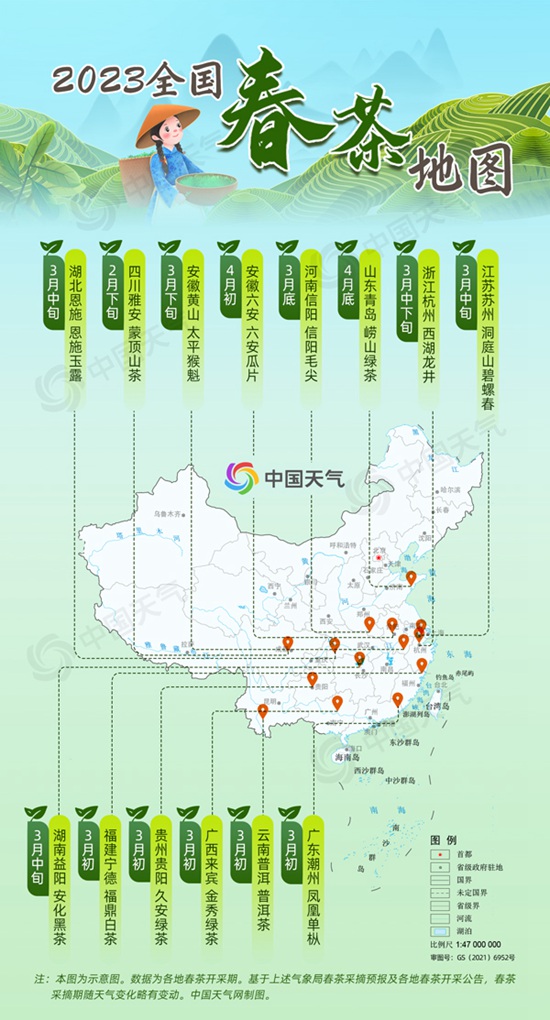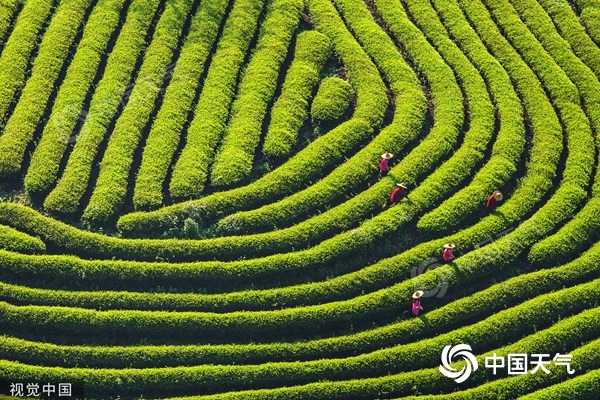China Weather Network News "Spring tea has been tasted since it was made, and the color and taste of Gan Xin are fragrant." It is another spring tea season. In March, the south of China is getting more and more spring, and the land is getting warmer. Tea farmers in major tea gardens are busy to ensure that the first batch of spring tea is listed on time. China Weather Network specially launched the national map of spring tea in 2023 to see where the spring tea has been exploited.
Spring tea has entered the four major tea producing areas in China, including Zhejiang and Jiangsu.concentratePicking period
People in China have tasted tea for thousands of years. Before the Tang Dynasty, the function of tea was mainly medicinal, and the custom of drinking tea became popular since the Tang Dynasty. Lu Yu, a "Cha Sheng", made a systematic study of tea and wrote a monograph on tea, Tea Classic. China tea culture, which flourished in the Tang Dynasty and flourished in the Song Dynasty, has been deeply integrated into the traditional culture of China through literature, art and religion, and tea has become one of the most interesting and national customs of Chinese people.

There are four major tea producing areas in China, all of which have spring tea, and the southwest producing areas and Jiangnan producing areas are relatively concentrated.
The southwest producing area is a plateau producing area, and the Yunnan-Guizhou Plateau has preserved the largest number of ancient tea trees in the world, which is regarded as the original producing area of tea trees in China. The first wave of spring tea this year has been listed, including Jiuan green tea, Pu ‘er tea, Mengdingshan tea and other varieties.
There are many varieties of spring tea in Jiangnan producing areas, mainly green tea, such as Biluochun in Dongting Mountain and Longjing in West Lake, etc., which entered the centralized picking period in mid-March. Biluochun in Dongting Mountain is produced in Suzhou. Since the spring of this year, the temperature in Biluochun tea producing area in Dongting Mountain is suitable and the light is sufficient, which is conducive to the germination of tea trees and the picking of fresh leaves. West Lake Longjing tea has a long history, which can be traced back to the Tang Dynasty, and the Longjing tea area gradually took shape in the Northern Song Dynasty. The average annual temperature in Hangzhou, the producing area of West Lake Longjing, is 16℃, and the annual precipitation is about 1500mm. The superior natural conditions are conducive to the growth and development of tea trees.
The above two kinds of spring tea have strict requirements on the time period of harvesting, and "tea before tomorrow" is the best. "Tea before the Ming Dynasty" is a proprietary name for people to divide the picking time of tea according to the solar terms. It is spring tea picked before the Qingming Festival. At this time, the tea is the most tender and fragrant, and it is the best quality tea in a year.
Among the four major tea producing areas in China, there are two producing areas in the south and the north, namely, the South China producing area south of Nanling and the Jiangbei producing area north of the Yangtze River. The producing areas in South China mainly include Guangdong, Guangxi, Hainan, Taiwan Province and other places, with humid climate. The main tea producing areas are mountainous areas, which are shrouded in fog all the year round and have a large temperature difference between day and night, which is very beneficial to the growth of tea trees. Spring tea can be mined in early March. Jiangbei production area is mainly located in the north of the middle and lower reaches of the Yangtze River, where the temperature is lower than other production areas, and the tea sprouts late. The spring tea varieties Xinyang Maojian and Laoshan green tea in this production area will not be mined until the end of March to April.
Meteorological conditions have great influence on the growth of tea trees, and temperature is the main factor.
In China, tea planting is mainly distributed along the Yangtze River to the coastal area of South China. Lu Yu said in the Book of Tea: "Tea makers are the best in the south." According to Shi Yan, a meteorologist of China Weather Network, the growth of tea trees requires temperature, precipitation and illumination. Tea trees like light and shade, the environment temperature is 20-25℃, and the area with annual precipitation over 1000 mm is most suitable for growth. Most of southern China has a warm climate, which provides unique natural conditions for the growth of tea trees.

The spring tea season is on, and Fujian tea farmers are busy picking. (Image from vision china)
The growth of tea trees is closely related to the temperature. Under natural conditions, the new buds of tea generally begin to sprout when the daily average temperature exceeds 10℃, and will stop growing when it exceeds 30℃. Before spring tea mining every year, the temperature fluctuation in tea-producing areas will affect the time when spring tea is on the market.
Judging from the varieties of tea, tea in China can be divided into six categories: green tea, black tea, green tea, black tea, white tea and yellow tea. It can also be divided into spring tea, summer tea and autumn tea according to different picking periods. In spring tea, there are many varieties of green tea. After a winter’s rest, tea trees are full of nutrients and rich in amino acids and other nutrients.
There are many ways to choose spring tea, and people can judge the quality of tea by looking, touching and smelling. Look, mainly depends on the shape, color and uniformity of tea; Touch, you can gently pinch the tea with your fingers to feel its dryness. If it is wet, it will affect the quality of the tea. Smell, by smelling the smell of tea to identify whether tea is moldy or deteriorated.
The development of tea culture has penetrated into every aspect of people’s life in China. In Jiangnan, Southwest and other areas with a long history of tea culture, tea has become an indispensable part of people’s appreciation of spring. Tea is processed into delicious food and served on the table, and the tea garden has become a beautiful scenery for people to feel the breath of spring. At present, spring tea in many tea producing areas in China has been mined and listed, so friends may wish to soak in a cup of spring tea and taste the taste of spring! (Text/Jiang Yi Design/Liu Hongxin Data Support/Shi Yan)
关于作者